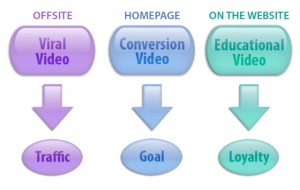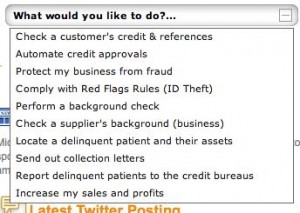It’s been a very long time since I’ve discovered an article about online video that made me shout “Amen.” Courtesy of ReelSEO, here’s “Three Types of Online Video for Business.” I especially like this visual below (the chart not the head shot, mkay). It helps simplify the relationship between the location of a video and its intent — whether it’s on a brand’s website to drive trial or increase purchase, or whether designed to drive awareness, trial or website visits.
 Only after I was done reading did I realize it was written by Daniel Sevitt — a WVFF reader/commenter who “discovered” me when he oversaw content at Metacafe, long before I had more than 100 YouTube subscribers. He liked my hippo and “annoy my son” videos there.
Only after I was done reading did I realize it was written by Daniel Sevitt — a WVFF reader/commenter who “discovered” me when he oversaw content at Metacafe, long before I had more than 100 YouTube subscribers. He liked my hippo and “annoy my son” videos there.
Sevitt is now with EyeView (check the blog) discovering that there was more to life than “unmanageable UGC, unimpressive CPM and unaccountable ROI.” Zoing!
I think when I plagiarize his article for my book I’ll turn this image into a funnel, where the “viral” content’s goal is to get someone to a website, and the video on the website is designed to convert them to a measurable action. Of course now that I’ve joked about this, Daniel, I’m going to have to spend five hours getting permission from you to satisfy Wiley requirements. 🙂
 Simply put, you want a lot of content on YouTube and other video-sharing sites to hedge your bets on search. Then ideally you’ve got a user path…
Simply put, you want a lot of content on YouTube and other video-sharing sites to hedge your bets on search. Then ideally you’ve got a user path…
- We captivate them with a funny or engaging video (or via a known weblebrity).
- We invite them to take an action (usually a site visit unless the ad is dynamic). Maybe 1-5 percent will do so.
- We convert some portion from grazers to customers (on website or with some lead-generation CRM tool).
- I’m not sure I’d invest much into loyalty, but I’m a jaded product director who found that (despite conventional wisdom) it’s sometimes easier to find new customers than bend the loyalty curve of the tiny base of customers that would be prone to loyalty-inducing video content. We could debate this over a beer or five.
I’d provide two additional thoughts I don’t think Daniel would dispute.
- I might even suggest that many sales can be consummated without dragging someone to a bloated product.com website. How many products are in your house? Good- have you been to any of the products’ websites?
- Although it’s ideal for businesses to create custom video content for various audiences and locations (online-video websites, blogs, product.com, or internal use), it’s a bigger crime to NOT post anything on YouTube or other popular sites.
It makes me crazy that brands have loads of engaging, informative, persuasive content… sitting in file cabinets or agency eRooms. Meh.
While you’re trying to find a way to engage audiences in entertaining ways, at least post your promotional or educational content on YouTube (provided it’s not archaic or horrible). If for no other reason this helps your search-engine performance (yeah, um, don’t sit on your ass hoping Google spiders will find some Quicktime video buried on your website).
Ideally your video is related to the search terms (which will tell you if a customer is exploring a category or ready to buy) or customized to a site’s context. But better something decent than nothing at all. Chances are your video won’t get a lot of “viral” views, but you want your message served upon Google and YouTube search results… not your competitors or a sour customer.








